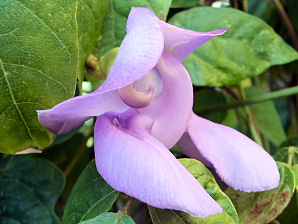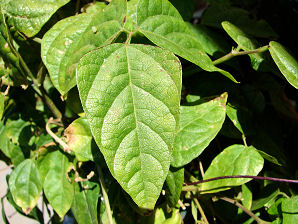Xeriscape Landscaping Plants For The Arizona Desert Environment.
Pictures, Photos, Information, Descriptions,
Images, & Reviews.
Vines.
Snail Vine, Vigna caracalla.
We Are Proud Of Our SafeSurf Rating!
Click On Any Of The Following Links By Amazon.Com
For Books, & Videos About Wildflowers Of Arizona & The Southwest USA. No Obligation!
 |
| Snail Vine, Vigna caracalla. Photo Taken At Glendale, Arizona. February 21, 2008. |
|---|
 |  |
| Snail Vine, Vigna caracalla. Flower. | Snail Vine, Vigna caracalla. Flowers. |
|---|---|
 |  |
| Snail Vine, Vigna caracalla. Leaves. | Snail Vine, Vigna caracalla. Vine. |
 /
/

Snail Vine.
We wish to thank Wikipedia, the free encyclopedia for some of the information on this page. We share images and information with Wikipedia. This fast growing perennial vine is so beautiful that on April 1, 1792, Thomas Jefferson wrote to Benjamin Hawkins about the Caracalla Bean saying "The most beautiful bean in the world is the caracalla bean which, though in England a green-house plant, will grow in the open air in Virginia and Carolina." We agree! It is fragrant as well as attractive, interesting, and long-lasting! Although known outsideof its natural habitat for over 250 years, this fascinating perennial vine remains little used in gardens. Especially in Arizona. Caracol [kar' ah kol] (Spanish for snail), flowers produce abundant nectar, a lure for a small sized bee. The nectar is very deep within the flower; therefore the bee must push its way between the petals to reach its reward. Also, as the keel petal is pushed downward, the stigma and stamens emerge from the tip of the keel. If the bee is carrying pollen from a previously visited flower, this will cross-pollinate the stigma. As the bee emerges from the flower, it will then pick up more pollen to carry to on the next flower. Once the bee flies away, the stigma and stamens retract into the keel keeping other insects from eating the pollen or from damaging the stigma. Snail Vine is hardy into the mid-twenties. If the frost kills the top in Phoenix, cut it to the ground, and it will restart in spring. It tolerates reflected heat! This plant is attractive to bees, butterflies and/or birds.
Quick Notes:
Height: Height to about 15 - 25 feet. Equal or greater spread.
Flowers: Papilionaceous, butterfly - like, and are borne in pendant clusters. White to yellow with lavender wing petals to an all pinkish - purple. The standard is ovate and the keel petal is strongly curled like a snail's shell. The bases of the standard, keel, and wing petals are pressed closely together.
Flowering Time: Mid March to October in Phoenix.
Seed Pod: A very long thin pod, 12 - 18 inches long and about 1/4 inch wide. An edible bean. Averaging about 14 seeds per pod.
Leaves: Dark green, glossy leaves are narrow oblongs with pointed tips. They and 2 - 3 inches long by about 1/2 inch wide. They are in opposite pairs along smooth twisted reddish - brown stems.
Found: Native to Central America to tropical South America. Mainly from Caracas in Venezuela. The USDA claims it is native of the USA (AL, AR, FL, GA, LA, MS, NC, SC, TN, TX, VA).
Hardiness: We know of several that were killed in Phoenix, when we had an abnormal freeze in 2010.
Soil pH requirements:
Sun Exposure:
Elevation: 800 to 5,800 feet In Arizona.
Habitat: Chalky/alkaline, Dry, Sandy, Well-drained/light soils. An ideal xeriscape landscape plant in Arizona.
Miscellaneous: Flowering Photos Taken At Glendale Arizona. February 21, 2008.
|



We Are Proud Of Our SafeSurf Rating!
Click On Any Of The Following Links By Amazon.Com
For Books, & Videos About Xerioscape Plants Of Arizona & The Southwest USA. No Obligation!
Back To Arizona Xeriscape Landscaping Main Page.
Back To Xeriscape Vines Page Two.
Back To Arizona Wild Flowers Home Page
Back To DeLange Home Page
© 1966 - Present, Audrey, Eve, & George DeLange
| © 1966 - Present, Audrey, Eve, & George DeLange |

